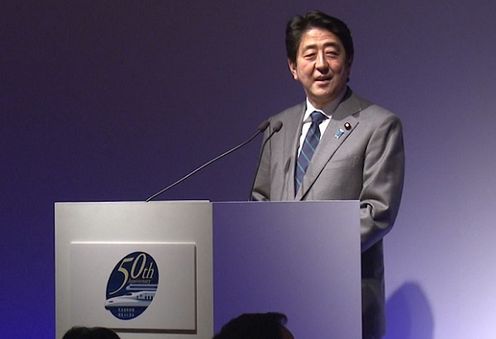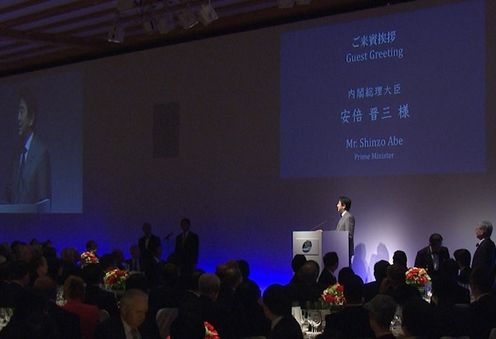Home > News > The Prime Minister in Action > October 2014 > Reception for the 50th Anniversary of the Start of Operations of the Tokaido Shinkansen
Reception for the 50th Anniversary of the Start of Operations of the Tokaido Shinkansen
Wednesday, October 22, 2014

Photograph of the Prime Minister delivering an address (1)

Photograph of the Prime Minister delivering an address (1)

Photograph of the Prime Minister delivering an address (2)
Prime Minister Shinzo Abe attended the Celebration of the 50th Anniversary of Start of Operations of the Tokaido Shinkansen at a hotel in Tokyo.
The Prime Minister said in his address,
“It gives me great pleasure today to see the 50th anniversary of the start of operations of the Tokaido Shinkansen.
‘Shinkansen.’ It’s a word that has become a standard term internationally. Initially, there were apparently those with opinions that the name ‘Shinkansen’ was not appropriate, as after a few years, it would no longer be Shin, or ‘new.’ In the end, however, they resolved to make the term ‘Shinkansen’ itself a brand name. I believe they truly had foresight.
The start of operations of the Tokaido Shinkansen was the same year as the opening of the Tokyo Olympic Games. At the time, I was 10 years old.
In the 50 years since then, Japan has always grown alongside the Shinkansen. Currently, the Tokaido Shinkansen serves 150 million passengers every year. In the past 50 years, there have been a total of 5.6 billion journeys taken on the Shinkansen. In terms of distance, that is equivalent to an astounding 2,700 round trips between the earth and the moon. Even the Apollo Project only made nine such round trips.
Moreover, the thing we should be most proud of is that there have been zero accidents injuring passengers throughout the history of the Tokaido Shinkansen. In addition, the Shinkansen is almost always on time, excluding times when there are abnormal weather conditions. The Shinkansen is symbolic of safety and peace of mind. In March of next year, the Shinkansen network will be extended to Kanazawa, and then to Hokkaido in the year after that.
Furthermore, right now, a project is starting for the Chuo Shinkansen, a next-generation high-speed railway using Superconducting Maglev (SCMAGLEV) . The idea that we might travel between Tokyo and Osaka in a little over an hour is no longer just a dream.
I believe that among those gathered here today are many who have taken a test ride on the SCMAGLEV test line in Yamanashi. I absolutely recommend that those who haven’t yet experienced it try it out. In April, I took a test ride on the newest SCMAGLEV with Ambassador Kennedy, who is here today. I had traveled on the SCMAGLEV before, but this time was comparatively quieter, smoother, and all-around more relaxing.
The development of technology over that time period was truly eye-opening. It is my hope that Shinkansen technology, including SCMAGLEV technology, can be extended widely overseas. First, I have just proposed to President Obama that this technology be introduced to the northeast part of the United States as a symbol of Japan-U.S. cooperation. If that is realized, it will be possible to travel between Washington D.C. and Baltimore in 15 minutes, and it will not even take one hour to get to New York. Furthermore, there are almost no late arrivals with the Shinkansen.
Looking back, the growth of Japan has progressed alongside the development of the Shinkansen. We are working hard every day to again revive Japan – a country which was once called the ‘land of the setting sun.’
I believe that Japan’s growth over the next 50 years will further progress alongside the evolution of the Shinkansen and the introduction of SCMAGLEV.
Once again, I offer my congratulations on the 50th anniversary of the start of operations of the Tokaido Shinkansen. I want to express my gratitude to everyone who has been involved with this dream project so far. I have high expectations that such work will bear fruit, and the Shinkansen will be the driving force for the further development of Japan’s economy and society in the future as well.
At the same time, when Shinkansen services were started in 1964, Japan was still poor, and had no money. Japan borrowed money from the World Bank and built this Shinkansen. I am deeply impressed that this was done not only through our own efforts, but also through the cooperation of people around the world. I thank everyone for that. I hope that, in terms of the paying back our debt for that support as well, Japan will continue to contribute to global development through this technology and financial support.
I would like to conclude my remarks upon this 50th anniversary with the wish that the Shinkansen continue to develop steadily. Congratulations.”

